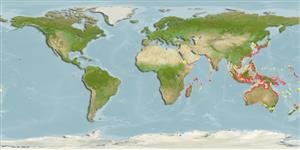Malacostraca |
Decapoda |
Epialtidae
Environment: milieu / climate zone / depth range / distribution range
Ecology
Benthic; depth range 15 - 170 m (Ref. 125642). Subtropical
Indo-West Pacific.
Length at first maturity / Size / Weight / Age
Maturity: Lm ? range ? - ? cm Max length : 3.7 cm CW male/unsexed; (Ref. 125642)
Maximum depth from Ref. 106287. Occurs in the lower intertidal shores and shallow subtidal area. Attach hydroids, sponges, bryozoans, compound ascidians, and pieces of algae onto its carapace (Ref. 108033). Found on substrates ranging from muddy, sandy, to shelly (Ref. 125642).
Life cycle and mating behavior
Maturity | Reproduction | Spawning | Eggs | Fecundity | Larvae
Members of the order Decapoda are mostly gonochoric. Mating behavior: Precopulatory courtship ritual is common (through olfactory and tactile cues); usually indirect sperm transfer.
Zheng, Y., X. Chen, J. Chen, Y. Wang, X. Shen, W. Chen and C. Li 2003 Biological resources and the environment in East China Sea. Scientific Technology Publishing of Shanghai, 835 p. (Ref. 75927)
IUCN Red List Status
(Ref. 130435: Version 2025-1)
CITES status (Ref. 108899)
Not Evaluated
Not Evaluated
Threat to humans
Human uses
| FishSource |
Tools
More information
Trophic EcologyFood items (preys)
Diet composition
Food consumption
Predators
Population dynamicsGrowthMax. ages / sizesLength-weight rel.Length-length rel.Length-frequenciesMass conversionAbundance Life cycleReproductionMaturityFecunditySpawningEggsEgg developmentLarvae PhysiologyOxygen consumption
Human RelatedStamps, coins, misc.
Internet sources
Estimates based on models
Preferred temperature
(Ref.
115969): 21.3 - 29, mean 28 (based on 272 cells).
Fishing Vulnerability
Low vulnerability (10 of 100).
